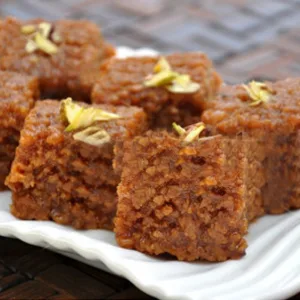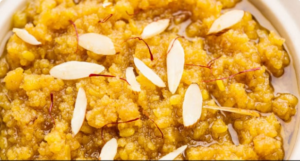Introduction of Halwa recipes :
Halwa is a traditional sweet dish that is popular in different cultures and regions around the world. It has a rich, juicy or gelatinous texture and a rich, sweet flavor. Halwa is made from a variety of ingredients such as grains, pulses, fruits, nuts, and vegetables, and is often flavored with spices such as cardamom, saffron, and rosewater. Halwa Halwa Halwa recipes recipes recipes
NO 1 : Sohan Halwa recipe :
Introduction of Sohan Halwa recipe :
Sohan Halwa, also known as Sohan Papdi, is a traditional and iconic sweet delicacy of Multan, Pakistan. It is popular among candy lovers for its rich, juicy texture and rich nutty flavor. Often enjoyed at festivals, weddings and special occasions, Sohan Halwa holds a special place in the traditional cuisine of Pakistan and India.

Ingredients :
-
Wheat Flour (Maida): The main ingredient of Sohan Halwa is wheat flour, which is roasted to perfection to enhance its flavor and aroma. -
Ghee (Clarified Butter): Ghee is used generously in Sohan Halwa to impart richness and a smooth texture to the sweet. -
Sugar: Granulated sugar is added to sweeten the halwa and provide the desired level of sweetness. -
Nuts: Sohan Halwa is typically loaded with a variety of nuts such as almonds, pistachios, and cashews, which add crunch and a nutty flavor to the sweet. -
Saffron (Kesar): Saffron strands are often used to infuse Sohan Halwa with a delicate aroma and a subtle golden hue.
Instruction :
Roast the flour: Roast the flour in ghee until it turns golden brown and has a nutty aroma. This step is very important to improve the taste of halwa.
How to make sugar syrup: In a separate pot, dissolve sugar in water to make a thick sugar syrup. The syrup is boiled until it reaches the desired consistency, usually using the single thread or softball method.
Mix the ingredients: Once the flour is toasted and the sugar syrup is ready, mix it with chopped nuts and saffron threads. The mixture is cooked over low heat, stirring constantly to avoid lumps and cook evenly.
Setting and Cutting: Once the halwa mixture thickens and separates from the sides of the pan, transfer it to a greased tray or plate and level it evenly. After it cools down a little, cut it into diamonds or squares with a sharp knife.
Garnish: Sohan halwa is often additionally garnished with chopped nuts and silver leaves (varak) to enhance its visual appeal.
NO 2 : Gajar Ka Halwa recipe :
Introduction :
Gajjar ka halwa, also known as carrot halwa, is a popular and acclaimed Indian dessert that originated in the northern Indian state of Punjab. Made with fresh carrots, milk, sugar, ghee (clarified butter), and a touch of cardamom, it creates a rich, creamy, and delicious dessert. Gajar ka halwa is traditionally enjoyed during Diwali, weddings and other special occasions.

Ingredients :
-
Carrots: Fresh, sweet carrots are the star ingredient of Gajar ka Halwa. They are grated and cooked until soft and tender. -
Milk: Full-fat milk is used to cook the grated carrots, imparting a creamy texture and richness to the halwa. -
Sugar: Granulated sugar is added to sweeten the halwa according to taste preferences. It melts into the carrots and milk to create a delicious syrup. -
Ghee (Clarified Butter): Ghee is used to sauté the grated carrots and adds a rich, buttery flavor to the halwa. -
Nuts: Chopped nuts such as almonds, cashews, and pistachios are added to Gajar ka Halwa for crunch and texture. They are typically roasted in ghee before being added to the halwa. -
Cardamom: Ground cardamom powder is used to flavor the halwa, imparting a warm and aromatic essence to the dish.
Instruction :
Preparing carrots: Wash, peel and grate fresh carrots on a grater or food processor. Gently squeeze the grated carrots to remove excess water.
Cooking carrots: Heat ghee in a thick bottomed pan or kadai and add grated carrots. Sauté until softened and the juices release, giving it a fragrant, caramelized appearance.
Add milk: Once the carrots are cooked, add the milk to the pan and simmer over low heat until the milk reduces and thickens and the carrots are soft.
Sweetening: Add sugar to the carrot and milk mixture and continue cooking the halwa until the sugar is completely dissolved and the mixture has a pudding-like consistency.
Garnish: Finally, add chopped nuts and cardamom powder to the halwa and cook for a few more minutes until the flavors meld.
How to serve: Gajar ka halwa is usually served warm with additional nuts and a pinch of cardamom powder. You can enjoy it as is or with vanilla ice cream for an even more special taste.
NO 3 : Moong Dal Halwa recipe :
Introduction :
Moong Dal Halwa is a popular Indian dessert that originates from the state of Rajasthan and is enjoyed across India. It is made from split yellow moong dal (mung dal), ghee (clarified butter), sugar, and milk, and is flavored with cardamom and saffron. This halwa is known for its rich, creamy texture and aromatic taste, making it a popular dish for festivals, weddings, and special occasions.

Ingredients :
-
Split Yellow Moong Dal: Moong dal is the primary ingredient used to make this halwa. The dal is soaked, ground into a coarse paste, and then cooked to perfection. -
Ghee (Clarified Butter): Ghee is used generously in Moong Dal Halwa to give it a rich and buttery flavor. It also helps in roasting the dal to achieve a golden color and enhances the overall texture of the halwa. -
Sugar: Granulated sugar is added to sweeten the halwa, providing the perfect balance of sweetness to the dish. -
Milk: Milk is added to the halwa to create a creamy consistency and to help in cooking the dal until it becomes soft and tender. -
Nuts: Chopped nuts such as almonds, cashews, and pistachios are often added to Moong Dal Halwa for extra flavor and texture. They are typically roasted in ghee before being added to the halwa. -
Cardamom: Ground cardamom powder is used to flavor the halwa, adding a warm and aromatic essence to the dish. -
Saffron: Saffron strands are sometimes added to Moong Dal Halwa to impart a rich golden color and a subtle floral aroma.
Instruction :
Preparing moong dal: Soak the split yellow moong dal in water for a few hours, drain and grind to a coarse paste using a food processor or blender.
Roast the dal: Roast the ground moong dal paste in a heavy-based pan or kadai with ghee until golden brown and fragrant. This step is very important to achieve the characteristic taste and color of halwa.
Cook the dal: Once the dal is roasted, gradually add the milk and cook the mixture on low heat until the dal is soft and cooked through. It is important to stir constantly so that the dal does not stick to the bottom of the pan.
Add sugar: Once the dal is cooked, add sugar to the mixture and continue cooking the halwa until the sugar completely dissolves and the mixture thickens.
Garnish: Finally, add chopped nuts, cardamom powder and saffron threads to the halwa and cook for a few more minutes until the flavors meld.
How to Serve: Moong Dal Halwa is usually served warm with a sprinkle of additional nuts and saffron threads. You can enjoy it as is or combine it with vanilla ice cream for an even more luxurious taste.
NO 4 : Besan Halwa recipe :
Introduction :
Besan halwa, also known as gram flour halwa or chickpea flour halwa, is a traditional Indian sweet dish prized for its rich, nutty flavor and melt-in-your-mouth texture. Besan halwa is made from chickpea flour (besan), ghee (clarified butter) and sugar, and is flavored with aromatic spices. It is a popular dessert eaten at festivals, celebrations, and special occasions.

Ingredients :
-
Gram Flour (Besan): The main ingredient of Besan Halwa is gram flour, which is roasted to perfection to enhance its flavor and aroma. -
Ghee (Clarified Butter): Ghee is used generously in Besan Halwa to impart richness and a smooth texture to the sweet. -
Sugar: Granulated sugar is added to sweeten the halwa and provide the desired level of sweetness. -
Nuts: Chopped nuts such as almonds, cashews, and pistachios are often added to Besan Halwa for texture and flavor. -
Spices: Aromatic spices such as cardamom powder, saffron, or nutmeg are used to flavor the halwa, adding depth and complexity to its taste.
Instruction :
Roast chickpea flour: Dry roast chickpea flour in ghee over low to medium heat until golden brown and nutty. This step is very important to create the rich flavor of the halwa.
How to make sugar syrup: In a separate pot, dissolve sugar in water to make a thick sugar syrup. The syrup is boiled until it reaches the desired consistency, usually using the single thread or softball method.
Mix the ingredients: Once the chickpea flour is roasted and the sugar syrup is ready, mix them and cook on low heat. The mixture is stirred continuously to avoid lumps and ensure even cooking.
Add Flavor: Add spices like cardamom powder and saffron to the halwa mixture to add flavor. Add the chopped nuts at this point, leaving some for garnish.
Cook until thick: Cook until the halwa mixture thickens and starts to pull away from the sides of the pan. You want a smooth, creamy consistency.
Garnish: Besan halwa is garnished with chopped nuts and sometimes dry fruits such as raisins before serving. It can be served warm or at room temperature, depending on your preference.
NO 5 : Badam Halwa recipe :
Introduction :
Badam halwa, also known as almond halwa, is a sumptuous and delicious Indian sweet dish known for its rich, creamy texture and appealing almond flavor. Badam halwa is made from ground almonds, sugar, ghee (clarified butter) and flavored with aromatic spices. It is a popular dessert eaten at festivals, celebrations, and special occasions.

Ingredients :
-
Almonds: The star ingredient of Badam Halwa is almonds, which are soaked, peeled, and ground into a fine paste. They impart a rich, nutty flavor and a creamy texture to the halwa. -
Ghee (Clarified Butter): Ghee is used generously in Badam Halwa to enhance its richness and impart a smooth, velvety texture to the sweet. -
Sugar: Granulated sugar is added to sweeten the halwa according to taste preferences. It melts into the almond paste to create a deliciously sweet syrup. -
Milk: Full-fat milk is used to cook the almond paste, adding creaminess and richness to the halwa. -
Saffron (Kesar): Saffron strands are often used to infuse Badam Halwa with a delicate aroma and a subtle golden hue. They are soaked in warm milk and added to the halwa during cooking.
Instruction :
Prepare the almonds: Soak the almonds in warm water to soften their shells and make them easier to peel. After peeling, grind it into a fine paste using a food processor or blender.
Cook the almond paste: Heat the ghee in a heavy-bottomed pan or kadai and add the almond paste. Cook the paste over low heat, stirring constantly to prevent it from sticking to the bottom of the pan.
Add sugar: Once the almond paste is cooked and fragrant, add sugar to sweeten the halwa. Stir the mixture until the sugar is completely dissolved and a thick syrup is formed.
Boil in milk: Add warm milk enriched with saffron bunches to the almond-sugar mixture and boil the halwa on low heat until it reaches a pudding-like consistency.
Garnish: Badam halwa is often served with chopped nuts such as almonds, cashews, and pistachios to add texture and visual appeal.
Serving: Badam halwa is usually served plain or warm with vanilla ice cream for a decadent dessert experience.
recipe recipe recipereciperecipereciperecipereciperecipereciperecipereciperecipereciperecipereciperecipereciperecipereciperecipereciperecipereciperecipe
